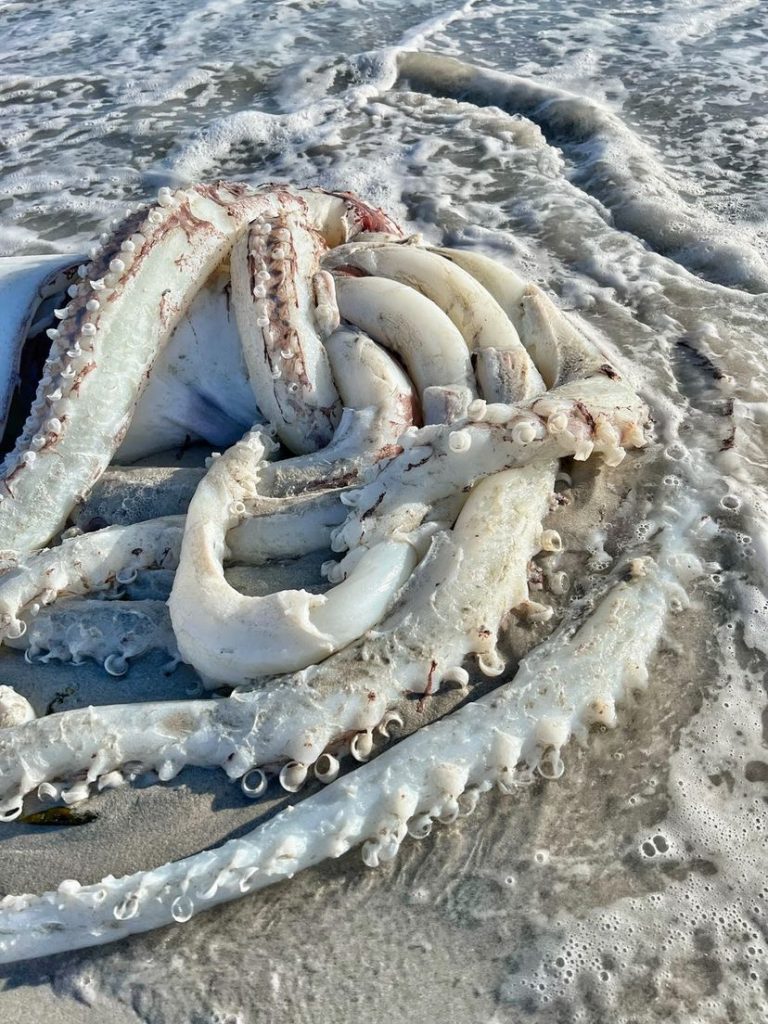The second giant squid to wash up on Western Cape beaches in two years was cut into chunks before it could be removed for observation. (Photos: Ali Paulus)
When Kommetjie residents were alerted that a giant squid had washed up on their beach, they could not fathom the size of the deep sea creature. The life of the female squid was cut short when she apparently came into contact with a ship’s propeller.
Among the Kommetjie residents who made their way to Long Beach was Ali Paulus, founder of Volunteer and Explore. He observed that the squid’s head alone was about two metres long and its arms were about three metres long.
“Having a detailed look at the squid’s arms, there were suckers with teeth in them. They are called chitin,” said Paulus. “You could also see on its head that it was cut by a boat’s propeller. There are cuts that are a straight line.”
In the past, beached marine creatures were taken to the Iziko Museum in Cape Town, which has a collection of preserved giant squids. But, as word of this particular squid spread, residents from neighbouring areas cut chunks of meat from its head, said Paulus.

“The neighbouring community came in and saw the squid as a source of food. It never made its way to the museum. Later in the day we wanted to go back to the squid, but the SPCA came and took the squid’s carcass away from the beach.”
According to Jaco Friedman, a wildlife officer at the Cape of Good Hope SPCA, the organisation salvaged a few tissue samples for the Iziko Museum. Most pieces of the squid that would have provided insight into its death had been removed by fishermen and trophy hunters.
“We saw a group of people gathered around the remains of the giant squid carcass that had washed ashore about an hour earlier. A group of local fishermen were busy sharing out pieces of the tentacles they had chopped off. The animal’s major organs were spread out around it and pieces of it were floating in the water,” said Friedman.
From the condition of its internal organs that were left behind, the SPCA could identify the squid was a two-year-old female in good health and her stomach was full. The SPCA put its remains back into the sea for consumption by other sea creatures.
From twilight zone to sandy shores
Giant squid are found in all oceans around the world, but it’s only when one washes ashore that people are afforded a rare glimpse into this mysterious species. Normally they are deep ocean dwellers, typically inhabiting depths of between 300m and 1 000m, the twilight zone of the ocean.
The giant squid found on Kommetjie’s Long Beach on 1 May was the second such finding in the Western Cape since June 2020, said Friedman. “The earliest recorded stranding of a giant squid on our beaches dates back to 1972. The last one we saw here was in 2020 when a squid measuring 4.5m stranded at Brittania Bay.”
According to Paulus, Kommetjie has been the site of a number of washed-up giant squid. In 1992, a nine-metre giant squid was the largest to have washed up on South Africa’s shores.
“As to her cause of death, I would say that she was most likely struck by a ship while she was at the sea surface, as giant squid are normally deep ocean dwellers,” said Friedman.
Unless there are suddenly more stranded giant squid along the coasts, Friedman said the latest case was not cause for alarm, other than to signal that the Western Cape was seeing more ship traffic, making animals vulnerable to run-ins with propellers.